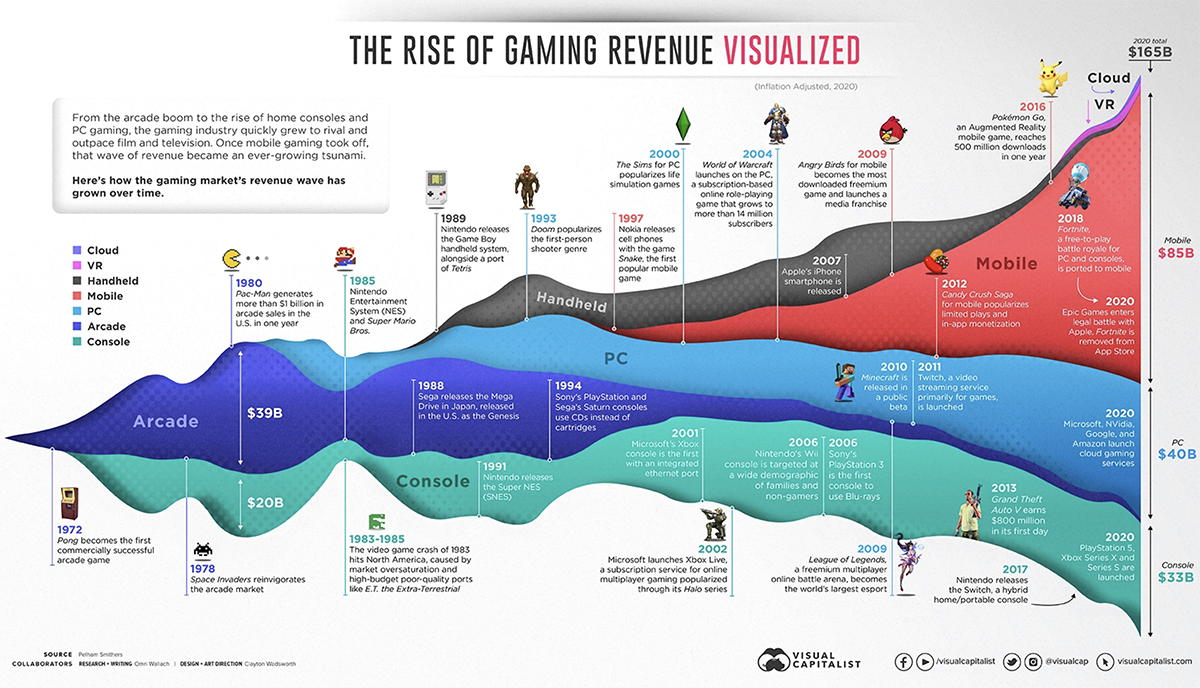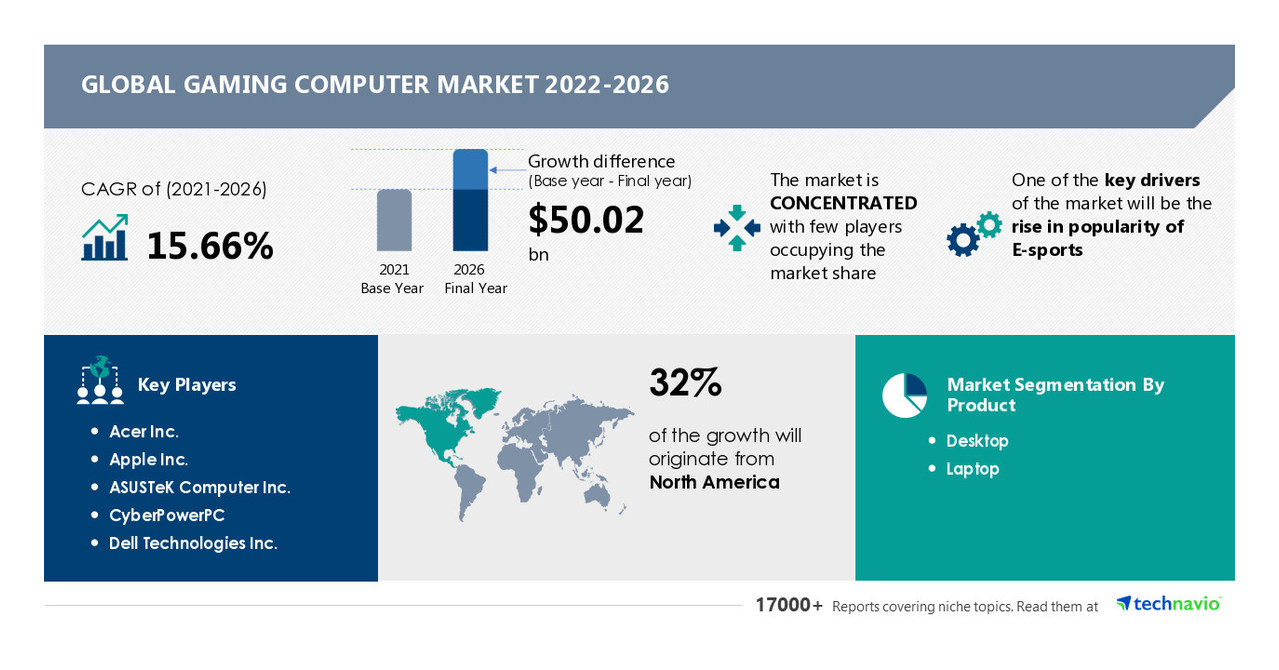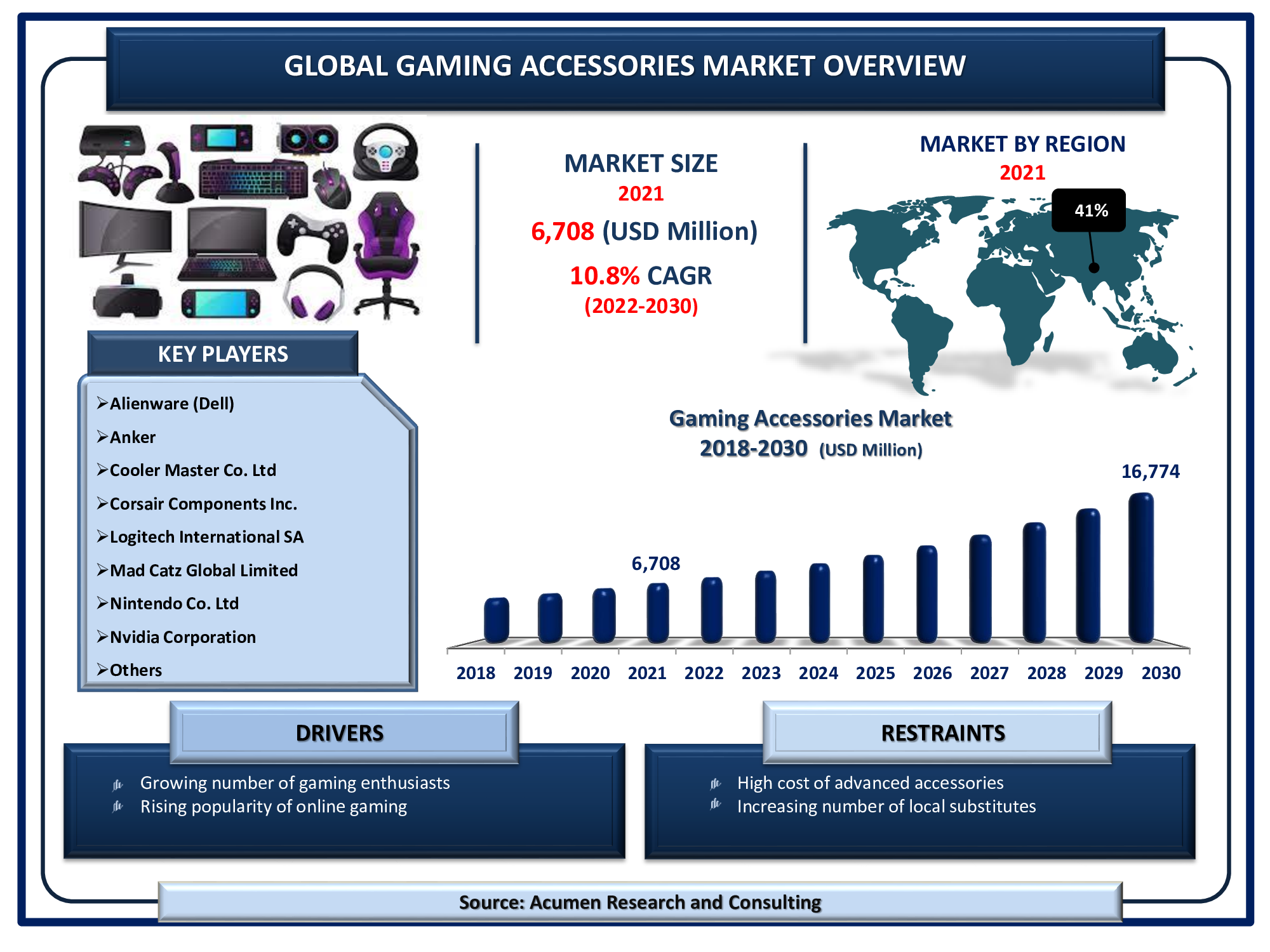
Content generated by MindOS.
MindOS may produce inaccurate information about people, places, or facts.

Content generated by MindOS.
MindOS may produce inaccurate information about people, places, or facts.
In this report, we will analyze four infographic tables that represent the gaming market's size, growth, and trends. The tables are sourced from various market research firms, including Technavio, IMARC Group, The Business Research Company, Verified Market Research, and Acumen Research and Consulting.

This infographic table from Visual Capitalist shows the gaming market's revenue streams from 1970 to 2020. The table illustrates how the gaming industry has evolved over the years, from arcade games to home consoles and mobile gaming. The table also highlights the significant revenue streams in the gaming industry, such as hardware, software, and accessories.

This infographic table from Technavio shows the gaming computer market's value and growth from 2021 to 2025. The table highlights how the increasing demand for high-performance gaming computers, coupled with technological advancements, will drive the market's growth. The table also illustrates the significant market players and their market shares.
.webp)
This infographic table from IMARC Group shows the global gaming market's size and share from 2023 to 2028. The table highlights how the increasing penetration of smartphones and the internet, coupled with the rising popularity of esports, will drive the market's growth. The table also illustrates the significant market players and their market shares.

This infographic table from Acumen Research and Consulting shows the gaming accessories market's size and forecast from 2021 to 2030. The table highlights how the increasing demand for gaming accessories, such as controllers, headsets, and keyboards, will drive the market's growth. The table also illustrates the significant market players and their market shares.
In conclusion, the gaming industry is experiencing significant growth, driven by technological advancements, increasing demand for high-performance gaming computers, and rising popularity of esports. The infographic tables analyzed in this report provide valuable insights into the gaming market's size, growth, and trends, enabling businesses to make informed decisions and stay competitive in this rapidly evolving industry.
The North America gaming market is one of the largest and most lucrative markets globally, with the United States being the primary contributor to the market. The market is highly competitive and fragmented, with several players operating in the industry. The market is driven by the increasing adoption of smartphones and the internet, which has made gaming accessible to a wider audience.
According to Mordor Intelligence, the North America gaming market is expected to grow at a CAGR of 11.8% over the next five years. The market is expected to reach USD 174.68 billion by 2028, up from USD 81.38 billion in 2020.
The increasing adoption of smartphones and the internet has made gaming accessible to a wider audience. The growing popularity of mobile games is due to technological advancements, such as AR, VR, cloud gaming, and 5G. Augmented reality is becoming ideal for mobile gaming due to its immersive and interactive technologies. Furthermore, regional telecom companies are aggressively making efforts to attract customers to use their 5G network. Hence, these regional vendors invest and innovate the software and platform to develop gaming applications by leveraging the upcoming 5G technology.
In the United States, gaming hardware, such as consoles, is expected to hold significant demand in the market. The gaming consoles provide an advanced graphical output that is unmatched by other alternative platforms. The video gaming is no longer a hobby exclusively for the young, and as generations have grown up with video gaming as a common part of life, the average gamer's age has risen. The key players in the market are introducing new technologies that propel market growth in the market.
The major companies operating in the North America gaming market are Activision Blizzard Inc., Electronic Arts Inc., Take-Two Interactive Software Inc., Zynga Inc., and Microsoft Corporation.
The North America gaming market is highly competitive and fragmented, with several players operating in the industry. The market is driven by the increasing adoption of smartphones and the internet, which has made gaming accessible to a wider audience. The United States is expected to hold a major market share due to the demand for gaming hardware, such as consoles. The major companies operating in the market are introducing new technologies that propel market growth in the market.
The gaming industry in North America is expected to reach a revenue of US$99.93bn by 2023, with an annual growth rate of 7.87% from 2023 to 2027. The projected market volume is estimated to reach US$135.30bn by 2027. The largest market in the industry is mobile games, which is projected to have a market volume of US$74.59bn in 2023.
The number of users in the gaming industry is projected to reach 292.30m by 2027, with a user penetration rate of 51.5% in 2023 and an expected increase to 56.0% by 2027.
In global comparison, China is expected to generate the most revenue in the gaming industry, with a projected revenue of US$109,200.00m in 2023.
The key players in the gaming industry include companies such as Activision (Call of Duty), PUBG Mobile, and GeForce Now.
Overall, the gaming industry in North America is expected to continue its growth trend, driven by the increasing popularity of mobile games and new business models such as subscription-based services. Technical innovations such as game streaming platforms are also expected to attract more casual gamers and revolutionize the way consumers play video games.
The gaming industry in North America is highly competitive, with multibillion-dollar companies and small players vying for market share. The industry has seen an influx of non-gaming companies seeking to enter the space, including technology and streaming giants. However, gaming executives view increased competition within the sector as a moderate or significant opportunity, as it creates innovation and new ideas.
In recent years, there has been a trend for gaming companies to use mergers and acquisitions (M&A) to acquire talent, technologies, and popular game franchises. In 2021, there were about 400 announced or closed gaming deals worth approximately $36.3 billion. However, when asked to identify which activities would position them best to succeed in the next three years, just 16% of gaming executives surveyed ranked M&A as a priority. This suggests an appetite for organic growth, with a focus on developing and delivering new products and services.
With customer expectations rising dramatically, a key pillar of success in the gaming industry will be continuous innovation and product differentiation. Gaming executives recognize this, with 83% of those surveyed saying that the industry is under constant pressure to innovate and create new gaming experiences. To drive organic growth, 50% of gaming executives plan to increase funding for research and development (R&D) in the next three years, while a similar number (44%) plan to invest in new technologies.
Interestingly, the favorable view of increased competition within the sector was shared by several executives, regardless of the size of their company's revenue. This suggests that smaller players have a fair chance of success in the industry, as long as they have technical and artistic acumen, along with business and operational excellence.
In conclusion, the gaming industry in North America is highly competitive, but this competition is viewed as an opportunity for innovation and new ideas. While M&A has been a trend in recent years, gaming executives are focusing on organic growth through R&D and investment in new technologies to drive product differentiation. The size of a company's revenue does not necessarily dictate its success in the industry, as long as it has the necessary skills and expertise.
The North America gaming industry is growing at a rapid pace, driven by factors such as rising smartphone adoption, internet penetration, and advancements in gaming technology. However, the industry also faces several risks and challenges that could impact its growth trajectory.
One of the significant risks facing the North America gaming industry is regulatory challenges. The industry is highly regulated, and companies operating in this space must comply with various laws and regulations. The regulatory environment is constantly changing, and companies must stay up-to-date with the latest developments to avoid penalties and fines.
The North America gaming industry is also vulnerable to cybersecurity threats, such as hacking, phishing, and malware attacks. These threats can compromise sensitive customer data, including payment information, and damage the reputation of gaming companies. Therefore, companies must invest in robust cybersecurity measures to protect their systems and customers from cyber threats.
The North America gaming industry is highly competitive, with several established players and new entrants vying for market share. The industry's growth has attracted significant investment, and new players are entering the market with innovative products and services. This increasing competition could lead to price wars and lower profit margins, forcing companies to invest more in marketing and R&D to stay ahead of the curve.
In conclusion, the North America gaming industry faces several risks and challenges, including regulatory challenges, cybersecurity threats, and increasing competition. Companies operating in this space must stay vigilant and invest in the right strategies to mitigate these risks and capitalize on growth opportunities.
The gaming industry in North America is witnessing significant growth, driven by rising smartphone adoption and internet penetration, advancements in AR and VR technologies, and the availability of high-speed internet connectivity. This section covers the major market trends shaping the North America Gaming Market according to our research experts.
The adoption of mobile gaming is on the rise due to technological advancements and enhancements, such as AR, VR, cloud gaming, and 5G. The accessibility of mobile games on smartphones is one of the primary reasons for their popularity. According to Ericsson, 5G connectivity is expected to drive the growth of the North American gaming market in the coming years. 5G subscriptions are forecast to increase drastically in North America from 2019 to 2027. Furthermore, regional telecom companies are aggressively making efforts to attract customers to use their 5G network, which will boost the development of gaming applications by leveraging the upcoming 5G technology.
In the United States, gaming hardware, such as consoles, is expected to hold significant demand in the market. The number of time users spend on gaming has been increasing as the number of games and the variety is increasingly diversified. Video gaming is no longer a hobby exclusively for the young. As generations have grown up with video gaming as a common part of life, the average gamer's age has risen. The key players in the market are introducing new technologies, which propel the market growth in the market. For instance, Microsoft Corporation released an Xbox app for smart TVs that enables consumers to stream Xbox video games even if they do not own consoles.
Augmented reality is becoming ideal for mobile gaming due to its immersive and interactive technologies. Furthermore, mobile games are the most popular AR genre in app stores. Apart from previously launched AR mobile games that are still popular, such as Pokémon Go and Ingress, vendors in the North American market are creating numerous new contributions to the category. Gaming consoles provide an advanced graphical output that is unmatched by other alternative platforms. According to a report by Entertainment Software Association, 63% of gamers in the United States made their purchase decision majorly based on the quality of graphics. The gaming consoles benefitted from their ability to support 4K content.
In conclusion, the North America gaming industry is witnessing significant growth due to rising smartphone adoption and internet penetration, advancements in AR and VR technologies, and the availability of high-speed internet connectivity. The United States is expected to hold a major market share due to the rising demand for gaming hardware, such as consoles. Augmented reality and advanced graphics are driving the gaming experience, making it more immersive and interactive.